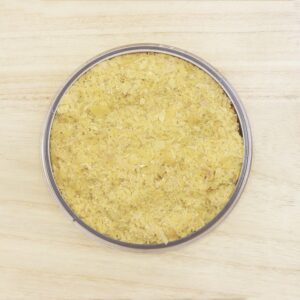Glazing agents are additives used to coat the surface of foods to give them a glossy appearance, improving consumer appeal, and/or to provide a protective coating that enhances shelf life.[6] They can also act as a barrier to moisture transmission or prevent the surface of the product from becoming sticky.[1]
Like other food additives, glazing agents are identified by their name and/or the E-numbering system, where “E” stands for Europe.[5]
They can be of natural or artificial origin, are used on both fresh and processed foods, and are not harmful to health.
Contents
What foods are they added to?
They are used on both fresh products, such as fruits and vegetables, and on processed products, such as chewing gum, fruit candies, licorice, chocolate and other confectionery products, and processed nuts.

In processed foods, they are added at the end of the manufacturing process.[1]
Examples of glazing agents
Natural glazing agents include are beeswax (E901), Candelilla wax (E902), carnauba wax (E903), shellac (E904), while artificial ones include microcrystalline wax (E905), hydrogenated poly-1-decene (E907), montan acid esters (E912), and oxidized polyethylene wax (E914).[2]
Below is a brief summary table.[3]
| E-number | Additive | |
| E901 | Beeswax, white and yellow | |
| E902 | Candelilla wax | |
| E903 | Carnauba wax | |
| E904 | Shellac | |
| E905 | Microcrystalline wax | |
| E907 | Hydrogenated poly-1-decene | |
| E912 | Montan acid esters | |
| E914 | Oxidised polyethylene wax | |
Health effects
The use of glazing agents, like that of other food additives, is regulated and authorized by the competent authorities, whose decisions are based on the scientific literature available at the time of the assessment.
Based on the scientific literature currently available, glazing agents, when used according to specific guidelines, are not harmful to health.[4]
References
- ^ a b Bhattacharya S. Chapter 11 – Other additives in snacks. Editor(s): Bhattacharya S. Snack Foods. Academic Press. 2023;283-319. doi:10.1016/B978-0-12-819759-2.00010-0
- ^ Blekas G.A. Food Additives: classification, uses and regulation. Editor(s): Caballero B., Finglas P.M., Toldrá F. Encyclopedia of Food and Health. Academic Press. 2016;731-736. doi:10.1016/B978-0-12-384947-2.00304-4
- ^ Commission Regulation (EU) No 1129/2011 of 11 November 2011 amending Annex II to Regulation (EC) No 1333/2008 of the European Parliament and of the Council by establishing a Union list of food additives. https://eur-lex.europa.eu/eli/reg/2011/1129/2013-11-21
- ^ EFSA Food additives: EFSA’s new guidance for applicants. Published: 18 July 2012. https://www.efsa.europa.eu/en/press/news/120718a
- ^ Food Standards Agency. Approved additives and E Numbers. Last updated: 23 January 2024.
- ^ Martins F.C.O.L., Sentanin M.A., De Souza D. Chapter 6 – Categories of food additives and analytical techniques for their determination. Editor(s): Galanakis C.M. Innovative Food Analysis. Academic Press. 2021;123-156. doi:10.1016/B978-0-12-819493-5.00006-6